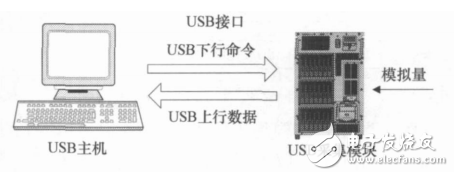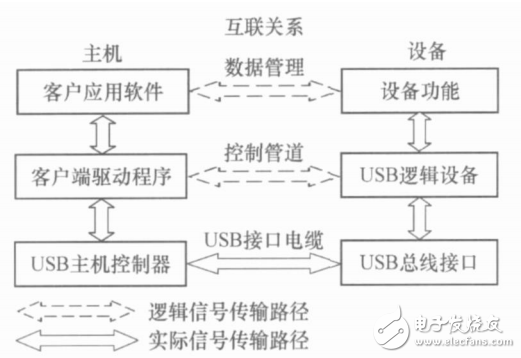Universal Serial Bus (USB) is widely used in computer peripherals, digital devices, and instrumentation due to its high transmission rate, plug and play, and ease of expansion. ARM embedded processors are widely used in market applications such as enterprise applications, automotive systems, home networking and wireless technologies due to their low cost and better performance. Combining USB and ARM is the ideal solution for data acquisition, processing and transmission.
1, USB data acquisition system overviewThe USB data acquisition system consists of two parts: the host and the USB device, as shown in Figure 1. In this system, the PC acts as a USB host, and the USB capture module acts as a USB device and is connected to the host through a USB interface. After the module is connected to the host, the host can correctly identify the device and initialize it (enumeration). After the device is initialized, the host sends the collection command and task parameters to the collection module. After the acquisition module correctly receives the command, the command is parsed and executed, and then the collected data is transmitted back to the host through the USB interface.
Divided from the level, the software and hardware resources of the USB system can be divided into three levels: the bus interface layer, the device layer and the functional layer. The interface layer involves a specific physical layer, which mainly implements the interaction between physical signals and data packets. It includes physical links, electrical signal environments, and packet transmission mechanisms. The device layer mainly provides a USB basic protocol stack to perform various operations of the general USB. And the request command is logically the data exchange between the USB system software and the USB logical device; the functional layer provides the specific functions required for each USB device, including the client application software and the device function block, which are directly between Logical correspondence. This correspondence indicates that the client application software only needs to consider how to implement specific device functions. The hierarchical relationship of USB is shown in Figure 2.

Figure 1 USB data acquisition system
2. Data acquisition system designThe selection of highly integrated devices in system development is not only easy to develop, but also the performance and reliability of the developed system is high. On the other hand, since the USB interface device is powered by the bus, considering the limited output power of the bus, it is beneficial to reduce the load of the USB bus by using a device with high integration. However, the selection of highly integrated devices and their development tools will lead to cost increases, so it is necessary to take various factors into consideration.

Figure 2 Hierarchical relationship of the USB system
Currently, there are two main development methods for USB: one uses an MCU with a USB interface, and the other uses an ordinary MCU and a USB communication chip. The latter is currently widely adopted, with relatively mature technology and low development costs. Since the STM32ARM itself has an A/D converter and a USB controller, it only needs one ARM to complete the function of acquisition and transmission, so there is no need to add a USB communication chip, but the cost of debugging is large.
Facade Display,Led Outdoor Display Screen,Low Power Led Light Buried Lamp,Soft-Panel Stage Lighting
Kindwin Technology (H.K.) Limited , https://www.ktlleds.com
